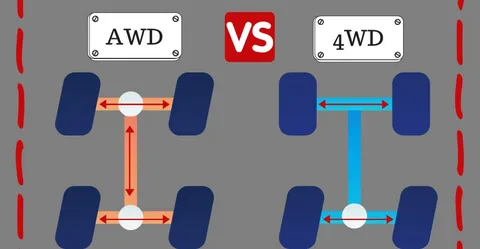AWD (All-Wheel Drive) and 4WD (Four-Wheel Drive) are both drivetrain systems used in vehicles to distribute power to all four wheels. While they serve a similar purpose, there are some key differences between the two, especially in regards to safety and trying to avoid getting involved in an accident.
- Operation:
AWD: In an AWD system, power is continuously distributed to all four wheels, and the system automatically adjusts the amount of power sent to each wheel based on traction conditions. AWD systems are typically active all the time and require no input from the driver.
4WD: In a 4WD system, power is typically sent to either two wheels (rear wheels in most cases) or all four wheels simultaneously. The driver can usually select between two-wheel drive and four-wheel drive modes manually. 4WD systems are commonly found in trucks and SUVs and are often used for off-road or low-traction conditions.
- Traction:
AWD: AWD systems are designed to improve traction on various road surfaces and weather conditions such as rain, snow, or mild off-road terrain. They provide enhanced stability and handling by automatically transferring power to the wheels with the most grip.
4WD: 4WD systems are primarily designed for off-road or challenging terrain. They provide better traction and torque to all four wheels simultaneously, which can be advantageous when driving on slippery surfaces or traversing rugged landscapes.
- Usage:
AWD: AWD systems are commonly found in passenger cars, crossover vehicles, and some high-performance sports cars. They offer improved stability and handling on different road conditions, enhancing overall safety and control.
4WD: 4WD systems are often found in trucks, SUVs, and vehicles built for off-road use. They are preferred for activities like towing, hauling heavy loads, and venturing into rugged off-road environments.
- Fuel Efficiency:
AWD: Generally, AWD systems consume more fuel compared to two-wheel drive systems because they require additional components and power to drive all four wheels continuously. However, advancements in technology have resulted in more fuel-efficient AWD systems in recent years.
4WD: 4WD systems are typically more fuel-consuming than two-wheel drive systems due to the added weight and mechanical complexity associated with transferring power to all four wheels. However, modern 4WD systems often offer selectable modes that allow the driver to switch between two-wheel drive and four-wheel drive, which can help improve fuel efficiency when 4WD is not required.
Can a car have both AWD and 4WD?
In most cases, a car cannot have both AWD and 4WD simultaneously. A vehicle is typically equipped with either an AWD system or a 4WD system, depending on its design and intended use. AWD systems are commonly found in passenger cars and crossover vehicles, where the focus is on enhancing traction and stability in different road conditions. These systems are typically always active, continuously distributing power to all four wheels and adjusting power delivery based on traction requirements.
On the other hand, 4WD systems are commonly found in trucks, SUVs, and off-road vehicles. They are designed to provide improved traction and torque for off-road or challenging terrain. In most cases, 4WD systems allow the driver to manually select between two-wheel drive and four-wheel drive modes, depending on the driving conditions. While it’s technically possible for a vehicle to be equipped with both AWD and 4WD systems, it is highly uncommon. A combination of both systems would involve a more complex and sophisticated drivetrain design, which is typically not seen in production vehicles. Additionally, having both systems would likely result in unnecessary weight, complexity, and increased fuel consumption.
What is Symmetrical AWD?
Symmetrical AWD refers to a specific type of all-wheel drive system developed by Subaru. It is a unique configuration that is characteristic of Subaru vehicles. In a Symmetrical AWD system, power is distributed to all four wheels in a balanced and symmetrical manner. The system features a longitudinally mounted boxer engine (horizontally opposed engine) and a symmetrical drivetrain layout. The key features of Symmetrical AWD are as follows:
- Balanced Power Distribution:
The Symmetrical AWD system provides equal power delivery to all four wheels consistently. This balanced distribution of power helps to optimize traction and stability, enhancing the vehicle’s overall handling and control.
- Symmetrical Drivetrain Layout:
The drivetrain components, including the transmission, driveshaft, and differential, are arranged in a symmetrical layout. This layout ensures that the length and weight of the drivetrain are evenly distributed between the front and rear wheels, contributing to improved balance and handling.
- Longitudinally Mounted Boxer Engine:
Subaru vehicles with Symmetrical AWD feature a horizontally opposed “boxer” engine, where the cylinders are arranged in a flat configuration. This engine design helps to keep the engine’s center of gravity low and centered, which further enhances the vehicle’s stability and handling characteristics.
- Continuous AWD Operation:
The Symmetrical AWD system is active at all times, providing power to all four wheels on a continuous basis. The system can adjust power delivery to individual wheels based on the available traction, ensuring optimal performance in various driving conditions.
Subaru’s Symmetrical AWD system has gained a reputation for its effectiveness in providing excellent traction, stability, and control, particularly in adverse weather conditions or challenging terrains. It has become a distinguishing feature of Subaru vehicles and is one of the reasons why Subaru is often associated with all-wheel drive capabilities.
How Does a Personal Injury Lawyer Help in AWD and 4WD Legal Liability?
Personal injury lawyers can play a crucial role in cases involving AWD (All-Wheel Drive) and 4WD (Four-Wheel Drive) vehicles and legal liability. Personal injury lawyers specialize in handling cases related to accidents and injuries. They have a deep understanding of the laws, regulations, and legal principles relevant to these cases. They can provide guidance on the applicable liability laws in your jurisdiction and how they may apply to your situation involving an AWD or 4WD vehicle. Personal injury lawyers have the skills and resources to investigate the accident thoroughly. They can gather evidence such as police reports, witness statements, accident reconstruction reports, and other relevant documentation. This information is essential in determining liability and building a strong case.
A personal injury lawyer will analyze the evidence and circumstances surrounding the accident to establish liability. They will evaluate factors such as driver negligence, traffic violations, and any specific issues related to the AWD or 4WD system that may have contributed to the accident. This analysis will help determine who is at fault and liable for the injuries and damages. Personal injury lawyers are experienced in dealing with insurance companies. They can handle communications and negotiations on your behalf, ensuring that your rights and best interests are protected. They will work to obtain fair compensation for your injuries, medical expenses, lost wages, pain, and suffering. Consulting with a personal injury lawyer will allow you to discuss the details of your situation and receive personalized advice and guidance based on your specific needs and legal jurisdiction.
In Conclusion:
AWD and 4WD vehicles have made significant progress in terms of technology and design since their initial inception centuries ago. Through the pioneering efforts of vehicle manufacturers, AWD and 4WD systems have become an important part of the automotive industry.








